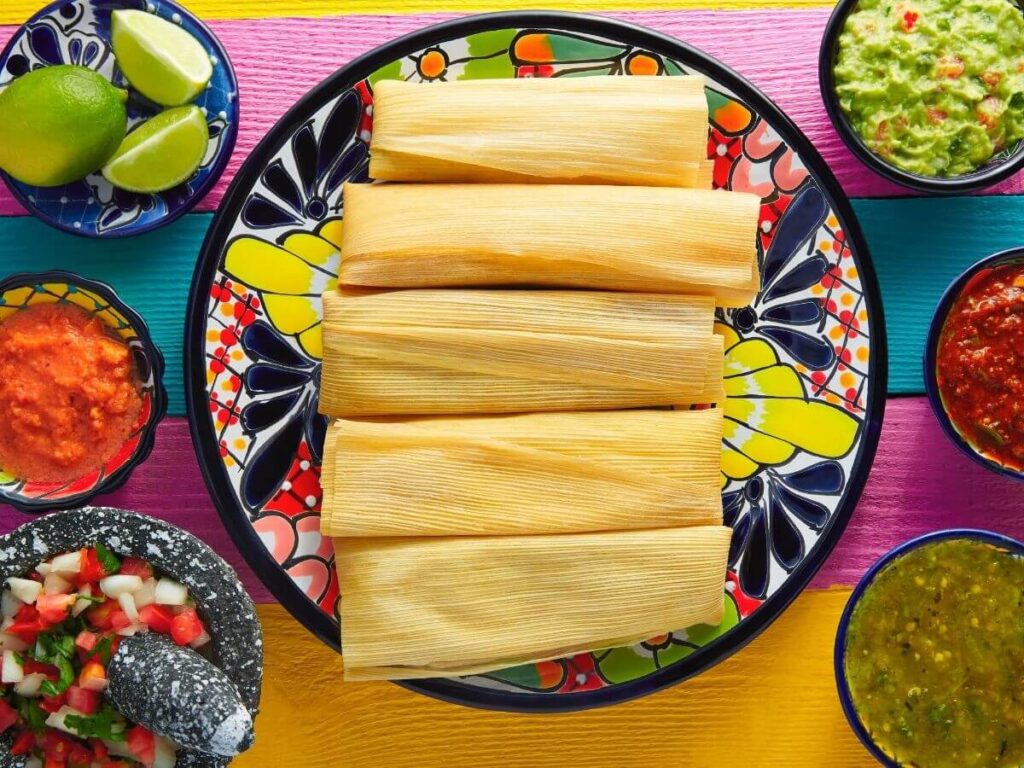
Tamales are a delicious and traditional Mexican dish you can enjoy any time of the year. They are made by wrapping masa dough around a filling, such as meat, vegetables, or cheese, and then steaming them to perfection. However, only some have a steamer in their kitchen. So, what do you do when you want to cook tamales but need a steamer? Don’t worry – there are a few alternative methods that you can use to achieve that perfectly cooked, tender, and flavorful tamale.
So if you are wondering how to cook tamales without a steamer? Keep reading, as we have a few tricks for you to try!
Can you cook tamales without a steamer?
Yes, it is possible to cook tamales without a steamer. While a steamer is a traditional and most efficient method for cooking tamales, you can use a few other cooking techniques to achieve similar results. There are a few ways you can cook tamales to perfection without using a steamer.
Different ways of cooking tamales without a steamer

While steaming is the traditional method of cooking tamales, the alternative methods are discussed below:
- Stove: Cooking tamales on the stove with a tight-fitting lid creates a steamy environment inside the pot, which helps cook the tamales evenly. Bring the water to a boil, then reduce the heat to low and simmer the tamales for about 45-60 minutes or until fully cooked.
- Pressure cooker/instant pot: A pressure cooker or instant pot creates a high-pressure, steam-filled environment that can cook the tamales quickly and efficiently. Don’t forget to follow the manufacturer’s instructions for cooking times and pressure settings.
- Oven: Using an oven to cook tamales is also similar to steaming. Placing the tamales in a covered baking dish with a bit of water creates steam inside the container, which can cook the tamales thoroughly. When you use an oven for cooking tamales, ensure to preheat the oven to the correct temperature before placing the tamales inside.
- Microwave: You can even cook tamales in the microwave, which is equivalent to steaming. Covering the tamales with a damp paper towel and microwaving them on high for a few minutes creates steam, which can help cook them.
Tips to Remember
Here are a few tips to remember while cooking tamales without a steamer:
- It’s important to check on them frequently to ensure they are cooking evenly. Use a thermometer to check the internal temperature of the tamales to ensure they are fully cooked.
- When cooking tamales without a steamer, it’s crucial to add enough liquid to create steam but not so much that the tamales become waterlogged. It is better to use a recipe that specifies the correct amount of liquid to add.
- Being patient and giving them enough time to cook thoroughly is important. Avoid opening the lid too often to check on the tamales; this can release steam and slow the cooking process.
- Boiling water for a long time can use up a lot of household energy and ramp up your monthly utility bills. To help you reduce your carbon footprint and energy costs, consider opting for some more energy-efficient appliances, such as a solar water heater. Click here to find out how a solar water heater works.
How to store tamales
Here are some tips on how to store tamales:
- Let the tamales cool entirely before storing them. Hot tamales can create condensation, which can lead to spoilage.
- You can refrigerate tamales within two hours of cooking. Place them in the refrigerator and store them for up to four days.
- If you want to store tamales for longer, you can freeze they can be frozen. Wrap each tamale in plastic wrap and place them in a freezer-safe bag. Tamales can be stored in the freezer for up to six months.
- When ready to eat your tamales, they can be reheated in the microwave, oven, or steamer. Be sure to remove the plastic wrap before reheating.
How to Cook Tamales Without a Steamer

- Preparation time: 5 minutes
- Cooking Time: 35 minutes
- Total Time: 40 minutes
- Servings: 4
Ingredients
- 4 frozen tamales
- Water, as required
Instructions
- Fill a large pot with enough water to reach just below the steamer basket’s bottom. This will ensure that the tamales do not come into contact with the water.
- Transfer the tamales to the steamer basket vertically. Ensure to make the open end face upward. This will help prevent water from getting inside the tamales.
- Once the tamales are in the basket, bring the water to a boil, then decrease the heat to maintain a gentle simmer. This will allow the tamales to cook through and become tender without becoming too dry or overcooked. Check the water level regularly and add more water if necessary to prevent the pot from boiling dry.
- Check the water level regularly to ensure enough steam to cook the tamales properly.
- The cooking time can take anywhere from 60 to 90 minutes; ensure to keep an eye on the water level and add more as necessary. It is essential to maintain a gentle simmer, as the tamales should cook slowly to achieve the desired texture.
- Once the tamales are cooked, let them rest for a few minutes to cool down before peeling away the husk. An adequately cooked tamale should feel firm to the touch, and the husk should easily peel away.
- If the tamales are not firm enough or you can peel the husk easily, return it to the pot and continue to steam until it reaches your desired consistency.

How to Cook Tamales Without a Steamer
Ingredients
Method
- Fill a large pot with enough water to reach just below the steamer basket's bottom. This will ensure that the tamales do not come into contact with the water.
- Transfer the tamales to the steamer basket vertically. Ensure to make the open end face upward. This will help prevent water from getting inside the tamales.
- Once the tamales are in the basket, bring the water to a boil, then decrease the heat to maintain a gentle simmer. This will allow the tamales to cook through and become tender without becoming too dry or overcooked. Check the water level regularly and add more water if necessary to prevent the pot from boiling dry.
- Check the water level regularly to ensure enough steam to cook the tamales properly.
- The cooking time can take anywhere from 60 to 90 minutes; ensure to keep an eye on the water level and add more as necessary. It is essential to maintain a gentle simmer, as the tamales should cook slowly to achieve the desired texture.
- Once the tamales are cooked, let them rest for a few minutes to cool down before peeling away the husk. An adequately cooked tamale should feel firm to the touch, and the husk should easily peel away.
- If the tamales are not firm enough or you can peel the husk easily, return it to the pot and continue to steam until it reaches your desired consistency.
FAQs
What To Serve With Tamales
Tamales can be served with a variety of side dishes. Some popular options include:
- Rice: Mexican or Spanish rice pairs well with tamales, adding a different texture to the meal.
- Beans: Refried or black beans make for a great side dish, providing extra protein and flavor.
- Salad: A simple green salad with a light dressing or avocado and tomato salad can balance out the rich flavors of tamales.
- Salsa: Salsa, guacamole, or a spicy dipping sauce can enhance the flavor of tamales.
Are Tamales Gluten-Free?
Yes, traditional tamales are gluten-free because they are made with corn masa which doesn’t contain gluten.
Are Tamales Dairy Free?
Some tamales are dairy-free, but not all. Traditional tamales made with corn masa, water, and lard are dairy-free.
What are some popular tamale fillings?
Some popular options include:
- Pork: Slow-cooked shredded pork in a spicy red sauce is a traditional and popular choice.
- Chicken: Shredded chicken in green salsa or mole sauce makes for a delicious savory tamale.
- Beef: Cooked and seasoned ground beef or shredded beef in a rich sauce adds a hearty touch.
- Vegetarian: Roasted vegetables, beans, or cheese can be used for a vegetarian or vegan tamale.
- Sweet: Fruit fillings like pineapple or strawberry, or chocolate mixes are great for sweet dessert tamales.
Can You Reheat Tamales?
Yes. Here are a few ways to reheat tamales.
Reheating in the Oven
Preheat your oven to 350°F. While it warms up, gently wrap each tamale in aluminum foil.
Place the wrapped tamales on a baking sheet or directly on the oven rack. Heat them for 20-25 minutes. Keep an eye on them to make sure they don’t become too dry.
When they’re done, carefully remove the tamales from the oven using oven mitts. Unwrap them and let them cool for a few minutes before enjoying your tasty, warm tamales!
Reheating on the Stove
To reheat your tamales on the stove, start by preparing a steamer setup. If you don’t have a steamer, you can create one using a pot and a metal colander. Fill the pot with just enough water so that it doesn’t touch the colander when placed inside. Bring the water to a gentle boil.
Place your tamales in the colander and cover with a tight-fitting lid. Make sure to arrange them in a single layer, with the open side facing up. This helps steam to circulate evenly, ensuring that all your tamales get reheated properly.
Steam your tamales for about 15-20 minutes, though this may vary depending on their size. Use a meat thermometer to check their internal temperature. You’ll know they’re ready when it reaches 165°F. If you notice the water level getting low in the pot, add more boiling water to keep it from drying out completely.
Once your tamales have reached the desired temperature, carefully remove them from the steamer using a pair of tongs or a similar utensil. Remember, the tamales will be hot, so use caution and allow them to cool for a moment before enjoying your delicious, perfectly reheated treat.
Reheating in the Microwave
Step 1: Begin by unwrapping your tamales, as it’s essential to take off the corn husks before microwaving. This prevents any unpleasant smells or potential fires that could occur if left on.
Step 2: Arrange the tamales on a microwave-safe plate, spacing them evenly. It’s crucial not to overcrowd the plate, as this may cause uneven heating. If you have many to reheat, consider using multiple plates or reheating in smaller batches.
Step 3: Use a small sprinkling of water to moisten the tamales slightly. This step ensures that they regain some of the lost moisture during the initial cooking process and prevents them from drying out in the microwave.
Step 4: Place a microwave-safe cover, such as a lid or another plate, over the tamales. The purpose of this is to trap the steam generated during the reheating process, which helps to maintain the desired texture of the tamales.
Step 5: Set your microwave to medium power (around 50-60%) and heat the tamales for about 3-4 minutes. The exact timing may vary depending on your microwave’s power and the number of tamales you are reheating, so be sure to keep a close eye on your tamales.
Check your tamales to ensure they’re heated through before enjoying. If needed, add more time in 30-second increments.
Can you overcook tamales?
Yes, tamales can be overcooked. When steaming tamales, the goal is to cook them until the masa (dough) is firm and cooked through and they have separated easily from the corn husks. Overcooking can occur if they are left to steam for too long after they have reached this point. Overcooked tamales may become too dry or hard, and the texture of the masa can become tough, diminishing their flavor and overall quality.
To avoid overcooking, it’s important to check the tamales for doneness after the recommended cooking time, which typically ranges from 1 to 2 hours depending on the size and thickness of the tamales. A good indication that tamales are done is when the masa no longer sticks to the corn husk and has a firm, spongy texture. It’s also helpful to use a timer and to adjust the cooking time based on the size and number of tamales being steamed.
